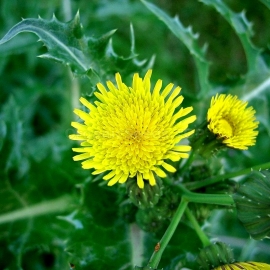







Organic Perennial Sowthistle Seeds (Sonchus Arvensis)
1.14 €
The young leaves can be used raw or cooked, they have a slightly bitter taste, and they can be added to salads or cooked like spinach. The leaves are rich in mineral salts and vitamin C.
-
Organic Perennial Sowthistle (Sonchus Arvensis)
Loose branching clusters of bright yellow, dandelion-like flowers, each up to 2 inches wide, at the ends of slender stalks. While individual plants may produce numerous flowers over the growing season, rarely are more than a few blooming at any given moment.
Some branches are producing seedheads while buds are just developing on others. New flowering stalks will also emerge from lower stem leaf axils as the plant matures and older stalks stop flowering and wither away or are broken or mowed off. Bracts and flower stalks are either densely covered in glandular hairs (glands are the tips of hairs) or gland-dotted (glands without hairs) depending on the subspecies.
Leaves have soft, spiny toothed edges that may be wavy, are hairless, mostly with small rounded lobes at the base that clasp the stem. Lower leaves are up to 2 inches wide and to 12 inches long and are somewhat variable in shape, having shallow or deep rounded lobes, occasionally unlobed. They tend to be crowded on the stem.
Leaves rapidly shrink in size as they ascend the stem. Upper leaves are generally unlobed and widely spaced on the stem, though most leaves are confined to the lower half of the plant. Stems are erect, unbranched except in the flowers, lined or weakly grooved, and hairless below the flowers.
This species is a rapid colonizer from deep, extensive underground root systems. Once listed as a Minnesota state noxious weed, it is now widely established throughout the state but is not as problematic agronomically as was once thought. Besides, Round-up Ready crops took care of much of the problem.
There are 2 recognized subspecies, both of which have been recorded in Minnesota: subsp. uliginosus (formerly var. glabrescens) which is gland-dotted but not glandular-hairy on bracts and flower stalks, is common throughout much of Minnesota, subsp. arvensis with glandular hairs has only been reported a few times.
Perennial Sowthistle is similar in appearance to Spiny Sowthistle (Sonchus asper) and Common Sowthistle (Sonchus oleraceus). Spiny Sowthistle has decidedly larger, spiny teeth on the leaves and larger lobes at the leaf base, and flowers typically less than 1 inch across. Common Sowthistle has more angled lobes on the leaves and flowers that are also 1 inch or less.
Uses
The young leaves can be used raw or cooked, they have a slightly bitter taste, and they can be added to salads or cooked like spinach. The leaves are rich in mineral salts and vitamin C. It might be best, though it is not necessary, to remove the marginal prickles. The stems can be cooked like asparagus or rhubarb. The young root can also be cooked or roasted. The roasted root is used as a coffee substitute.
The leaves are used as a poultice and are said to have anti-inflammatory activity. An infusion of the leaves has been used in the treatment of caked breasts. A tea made from the roots is used in the treatment of asthma, coughs and other chest complaints. A tea made from the leaves is said to calm the nerves.
